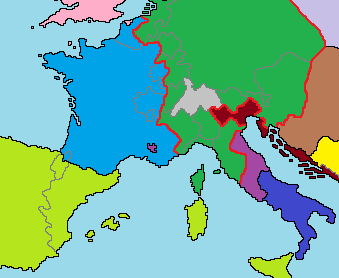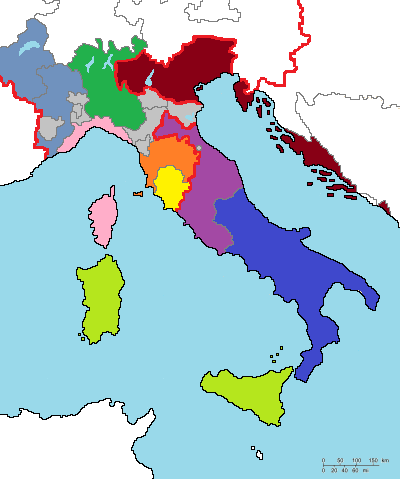THE ITALIAN WARS 1494-1559

Europe on the Eve of the Italian Wars
- Light Blue - Kingdom of France
- Light Green - Kingdom of Spain
- Dark Green - Holy Roman Empire
- Dark Blue - Kingdom of Naples
- Dark Red - Republic of Venice
- Purple - Papal States
- Grey -Swiss Confederation
- Pink - Kingdom of England
- Brown - Kingdom of Hungary
- Yellow - Ottoman Empire
- Lilac - Poland-Lithuania
FEUDALISM & THE RISE OF THE HAPSBURGS
The Italian Wars [1494-1559] were the last of the great medieval wars that pitched Western Europe's rival dynasties against each other. In subsequent centuries Europeans would slaughter each other in the name of religion, trade, nationalism and differing political philosophies but The Italian Wars were an inevitable product of the Feudal society that had existed in Western Christendom since the end of the Roman Empire.
The Feudal System had its origins in the barbarian war bands that had conquered Rome during the 4th and 5th Centuries. Victorious tribal chiefs would divide their conquests among their faithful retainers in exchange for promises of military service and this made the ownership of land the basis of wealth and political power throughout the Middle Ages.
The flaw in the system was that feudal monarchs had to acquire ever more territory, either through war or marriage, to increase their political power and the resulting disputes over land produced the endless series of wars between Europe's dynasties.
By far the most successful of the players in this historical game of thrones was the House of Hapsburg who emerge into the light of history during the 11th Century. The first Hapsburg, the wonderfully named Count Radbot of Klettgau, was an obscure baron from the Swiss Alps but his descendants built a vast empire that included Austria, Germany, Bohemia, the Low Countries, Spain, most of Italy and even the Americas.
THE STRUGGLE BETWEEN FRANCE & GERMANY
By the end of the 15th Century, the Hapsburgs had seized control of the theoretically elective Holy Roman Empire but their relentless expansion brought the Hapsburg emperors Frederick III [1415-93], Maximilian I [1459-1519] and Charles V [1500-1558] into conflict with the French Valois kings Charles VIII [1470-98], Louis XII [1462-1515] and Francis I [1494-1597] who had their own dynastic ambitions in Europe.
The chief battlegrounds for the Hapsburgs and Valois monarchs were the strategic areas along their respective borders. These disputed lands included Burgundy, the Low Countries, Alsace, Lorraine and later the Pyrenean kingdom of Navarre. Both houses also coveted the Italian crowns of Lombardy and Naples.
Apart from the wealth these territories offered their conquerors, the French and German successors to Charlemagne, the first Holy Roman Emperor, believed possession of Italy would make them the rightful heirs of the ancient Caesars and legitimise their right to rule all of Western Christendom.

Disputed territories claimed by the Hapsburg & Valois kings during the 15th and 16th Centuries
- Orange - Duchy of Burgundy
- Gold - Kingdom of Lombardy
- Yellow - Kingdom of Naples
- Buff - Kingdom of Navarre

Italy in 1494
- Dark Green - Duchy of Milan
- Blue Grey - Duchy of Savoy
- Dark Blue - Kingdom of Naples
- Light Green - Spanish Sicily & Sardinia
- Purple - Papal States
- Dark Red - Republic of Venice
- Pink - Republic of Genoa
- Orange - Republic of Florence
- Yellow - Republic of Siena
- Grey - Minor City States
Note: Milan, Savoy, Genoa, Florence, Siena and the minor city states of Northern Italy were semi-independent territories within the Holy Roman Empire (as indicated by the red line).
THE UNION OF HAPSBURG GERMANY, ITALY & SPAIN
In 1494 the French king Charles VIII became the latest entrant in the interminable Franco-German struggle for Italy when he revived his tenuous claim to the throne of Naples, however the Neapolitan kings had powerful allies. At the end of the Middle Ages, Naples was ruled by a junior branch of the Spanish Royal House of Aragon so the king of Spain had feudal duty to protect his Italian vassal.
To complicate matters further the current King of Aragon Ferdinand II and his wife Isabella Queen of Castile (the same Ferdinand & Isabella who'd completed the Reconquest of Spain from the Moors and financed Christopher Columbus' voyage of discovery) had recently married their daughter Joanna the Mad to a Hapsburg prince: Philip the Handsome.
Philip was the son of the Hapsburg Holy Roman Emperor Maximilian so Charles must have known that invading Naples would provoke both Spain and Imperial Germany. However Charles had probably realised that any son born to Joanna and Philip would unite Spain, Italy and Germany in a single empire that would stretch from the Portugal to Poland anyway.
War was the only way Charles could prevent the encirclement of his kingdom by the House of Hapsburg so, in 1494, he crossed the Alps at the head of an army of 25,000 men. The Italian Wars, which would devastate the Italian Peninsular for the next sixty five years, had begun.